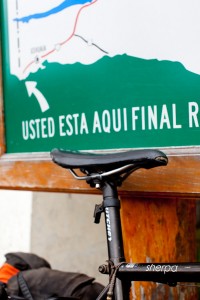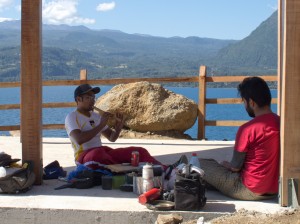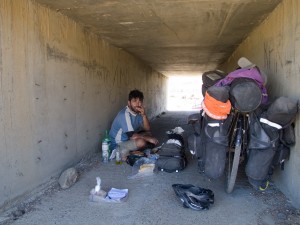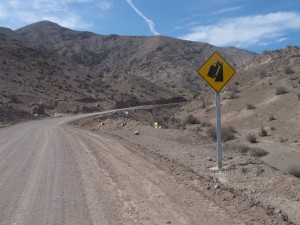 With my hair growing endlessly as kilometres go by, I get out of Bolivia and enter Chile at the end of October 2013. If some of my friends were telling me «Already in Chile! You’re almost done! Only two countries left!», I was receiving the encouragement while clarifying. We forget that Chile, with an atypical geographical form of a thin land layer stuck between the Pacific and the Andes of 180 kilometres in average (going between 90 y 400 kilometres), stretches for almost 4.300 kilometres from North to South. With it’s neighbour, the country shares the third longest border of the world (after Canada/USA and Russia/Kazakhstan). Argentina, quite wider, is the eighth biggest country of the world. Through both countries, I cycled 7,625 kilometres, which represents almost a quarter of all what I did through the Americas!
With my hair growing endlessly as kilometres go by, I get out of Bolivia and enter Chile at the end of October 2013. If some of my friends were telling me «Already in Chile! You’re almost done! Only two countries left!», I was receiving the encouragement while clarifying. We forget that Chile, with an atypical geographical form of a thin land layer stuck between the Pacific and the Andes of 180 kilometres in average (going between 90 y 400 kilometres), stretches for almost 4.300 kilometres from North to South. With it’s neighbour, the country shares the third longest border of the world (after Canada/USA and Russia/Kazakhstan). Argentina, quite wider, is the eighth biggest country of the world. Through both countries, I cycled 7,625 kilometres, which represents almost a quarter of all what I did through the Americas!
If on one side, I was looking at weirdly through well shaved men, on the other side, I was integrated more easily with my long hair and my beard, where everything is more relax (on which point Chilean don’t hesitate to point out the laziness of their neighbours). Unfortunately, I can’t cut my hair and put them back at each border crossing.
Still on the leftover of the economic crisis from the beginning of the millenary, Argentina faces a galloping inflation and chronic devaluation. It doesn’t affect their smiles to visitors though. Travel culture is well implemented while in better times, the Argentinian peso gave them the opportunity to travel to many places with ease, even more on the rest of the South American continent. Today, with the difficulty they face to gather foreign currency, they focus travelling in their own country. They’ll share their nostalgia about their former trip (with a bit of bitterness about today’s central government regulations) and make you welcomed in their country.
Chile is proud of it’s wealth, but in the street the look of people avoid often the foreigner passing by. Chileans aren’t anti-social, but more distant. If time and opportunity make you get closer and build a confidence relationship, you get to know the friendly Chilean hidden under his shell. Leftover from dictatorship times? It’s true that we don’t feel the same distance toward younger people, the youth from the Penguin Revolution (learn more here) who doesn’t seem to have this primary distrust toward the Other. Unlike their seniors, they don’t hesitate to wave hello, talk to us and smile while we pass by.
My zigzag through the Andes will bring me to cross the border nine times. The choice of this maybe-crazy itinerary will make harder to not draw comparisons between the paises hermanos, the brother countries, which why come up the choice of presenting both of them in the same country-report, the last one of almost two years of adventures.
Numbers and letters
Chile
From October 25, 2013 to April 20, 2014
72 days, 49 of them on the bicycle
Rainy days: 7
Days with frost in the morning: 10
3,542 km (5 segments of 974, 1195, 389, 564 and 420 km)
8 crossings of the Great Continental Divide
4 flat tires, 6 broken spoke and a broken hub
72.28 km per biked day in average (49.19 per total days)
Average speed of 13.3 km/h
Longest day: 160 km
Shortest day: 9 km
Fastest day 19.4 km/h
Slowest day: 5.5 km/h
Maximum speed: 107.1 km/h
Well yeah, 107.1: the overweight bicycle with water and food, a extraordinary straight line downhill on smooth pavement with an unbelievable tailwind toward Paso de Jama, close to my first entry in Argentina. Euphoria, fear, fun, regrets, all this mixed together and even more. But to be franc, from 80 km/h an hour and up, you don’t really feel the speed difference: it goes fast.
Argentina
From November 12, 2013 to April 27, 2014
69 days, 58 on the bicycle
Rainy days: 14
Days with frost in the morning: 3
4,084 km (5 segments of 1385, 590, 606, 1171 and 332 km)
7 crossings of the Great Continental Divide
1 flat tire and 4 broken spokes
70.42 km per biked day in average (59.19 per total days)
Average speed: 14.4 km/h
Longest day: 167 km
Shortest day: 17 km
Fastest day: 22.7 km/h
Slowest day: 5.9 km/h
Maximum speed: 66.8 km/h
What to eat?
 Let’s start with what’s common to both countries: out! the easiness of eating in small restaurants along the way like Ecuador, Peru and Bolivia. A thicker wallet would be necessary. But there is an infinite choice of wonderful sight for the eye to establish a picnic spot. Back to rice and noodles meals, like at the beginning of the trip, but also to polenta, way faster to cook.
Let’s start with what’s common to both countries: out! the easiness of eating in small restaurants along the way like Ecuador, Peru and Bolivia. A thicker wallet would be necessary. But there is an infinite choice of wonderful sight for the eye to establish a picnic spot. Back to rice and noodles meals, like at the beginning of the trip, but also to polenta, way faster to cook.
Crossing the border like I did need a little bit of food management to not waste the precious calories. Chile applies a strict but unequal food entry control to protect their agriculture. It is forbidden to enter with meat, fruits, vegetables, nuts, dairy produce and other fresh produces. After the entering administrative process, a agent will inspect your luggage, with a technique going from giving a glance at the bag where you said your food was to pass all your luggage into big machines. In Argentina, it is also theoretically forbidden to enter with fresh food but control is almost inexistent. «Almost» because one time Guillermo got caught by a bit zealous trainer agent. Is this trainer will convince the custom agent to go through arduous tourist inspection in the future? We’ll see.
If we don’t eat in restaurant, it is nonetheless the dessert paradise in Argentina, from pastries to cookies through ice cream. Facturas, little varied pastries, are bought to the dozen or half dozen and you can even ask sometimes for yesterday’s leftovers so it’s even cheaper. We found healthy, energetic and delicious cookies in the grocery stores and when you take the time to read the label, you realize that they are made by an Adventist religious group. If they make their mission to feed better the Argentinians while furnish their vault, I don’t know if they are aware that many cyclists made that an important part of their snacking diet. Don’t get fussy on buying an ice cream cone at the end of a warm day: better share (or just indulge yourself) half a kilo or even a kilo of three or four different flavour, and this without ruining yourself. A delicious discovery was made a little bit late through the country: Mantecol, a kind of bar with a peanut paste base, kind of puffy but compact at the same time, quite fat, quite sweet, that I won’t eat if I was sedentary but oh! such a comfy food into the wide and open Patagonia. You can also get crazy about dulce de leche, a creamy caramel worth it’s national pride, to spread a little bit everywhere, even more on slightly salty crackers.
In Chile, the food is more sad and more expensive. The cookie and cracker aisle in the grocery store is dominated by the geant Costa and its taste of refined sugar, which hasn’t avoid me to binge on too many packs. Dulce de leche is called manjar, and Nestlé might have killed all the local production even though its bad taste. Better bring an unopened jar of La Serenissima from Argentina (it would be confiscated – and probably eaten – at the border if it’s opened). Fruits and vegetables might have the format and aesthetic of exportation for the Northern Hemisphere, there not cheaper even if they grew up just beside.
And I haven’t talked about the empanadas yet, perfect for fill in an empty corner of the stomach. The ones in Chile are big, thick crust, oven baked and filled with good stuff in a few variety, the pino ones having the whole lot, from the cooked egg to the black olive. The ones from Argentina are smaller, thin crust, baked but sometimes fried, with a largest quantity of flavour. Different from one country to an other and hardly comparable, in both case perfect for an afternoon snack (if you get into a town at that moment of course!)
Where to sleep?
 Out! as well the small hotels, or at least an option to keep only for very few occasions, for three or four times the price of Peru. In big cities where a place like that would be even more expensive, youth hostels give encounters with other travellers and equipped kitchen. It’s the return of organized campgrounds, which I haven’t seen since I left USA. In Chile, campings are only in tourist places and aren’t always cheap. In Argentina, even the smaller towns have a municipal campground. The less developed are free, mainly in the Northern part of the country, while it is expected to pay in touristy towns. They are generally equipped with a structure to grill your food, so you just need to start a fire and get a piece of meat to the butcher somewhere and you’ll have a nice evening. One both side, wild camping can be done without too much worry. If there is too much wind, consider under the road! Don’t neglect neither the hospitality of fireman or even policeman in small towns posts, even more when it’s raining. In Southern Argentina, where distance between towns is important, some road maintenance posts are scattered, where the people working there are generally keen on giving you a hand.
Out! as well the small hotels, or at least an option to keep only for very few occasions, for three or four times the price of Peru. In big cities where a place like that would be even more expensive, youth hostels give encounters with other travellers and equipped kitchen. It’s the return of organized campgrounds, which I haven’t seen since I left USA. In Chile, campings are only in tourist places and aren’t always cheap. In Argentina, even the smaller towns have a municipal campground. The less developed are free, mainly in the Northern part of the country, while it is expected to pay in touristy towns. They are generally equipped with a structure to grill your food, so you just need to start a fire and get a piece of meat to the butcher somewhere and you’ll have a nice evening. One both side, wild camping can be done without too much worry. If there is too much wind, consider under the road! Don’t neglect neither the hospitality of fireman or even policeman in small towns posts, even more when it’s raining. In Southern Argentina, where distance between towns is important, some road maintenance posts are scattered, where the people working there are generally keen on giving you a hand.
Roads
 For all tastes! There are generally always a way to avoid the main axis. From our experience, Argentinians driver are way more conscious about road sharing than Chileans. Argentina generally has less steep roads as well, the geography helping. Indeed, Chile gets into my top 3 experiences with steep roads, Ecuador ahead and Guatemala and Chile sharing second place.
For all tastes! There are generally always a way to avoid the main axis. From our experience, Argentinians driver are way more conscious about road sharing than Chileans. Argentina generally has less steep roads as well, the geography helping. Indeed, Chile gets into my top 3 experiences with steep roads, Ecuador ahead and Guatemala and Chile sharing second place.
The Chilean Ministry Public Works keeps an interactive cartography of the country which permits you to print your own maps. This link will bring you to a pdf document with all habilitated border crossing between Chile and Argentina.
I gather here the different maps from North to South of each road segment.
Segment 1 Chile
Segment 2 Argentina
Segment 3 Chile and Argentina
Segment 4 Chile
Segment 4 Argentina
Segment 5 Chile and Argentina
